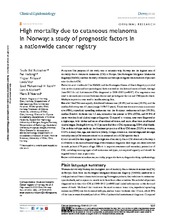| dc.contributor.author | Robsahm, Trude Eid | en_US |
| dc.contributor.author | Helsing, Per | en_US |
| dc.contributor.author | Nilssen, Yngvar | en_US |
| dc.contributor.author | Vos, Linda | en_US |
| dc.contributor.author | Rizvi, Syed Mohammad Husain | en_US |
| dc.contributor.author | Akslen, Lars A. | en_US |
| dc.contributor.author | Veierød, Marit Bragelien | en_US |
| dc.date.accessioned | 2019-05-28T12:17:02Z | |
| dc.date.available | 2019-05-28T12:17:02Z | |
| dc.date.issued | 2018-05-09 | |
| dc.Published | Robsahm R, Helsing P, Nilssen Y, Vos L, Rizvi SMH, Akslen LA, Veierød MB. High mortality due to cutaneous melanoma in norway: A study of prognostic factors in a nationwide cancer registry. Clinical Epidemiology. 2018;10:537-548 | eng |
| dc.identifier.issn | 1179-1349 | |
| dc.identifier.uri | https://hdl.handle.net/1956/19770 | |
| dc.description.abstract | Purpose: The purpose of this study was to examine why Norway has the highest rate of mortality due to cutaneous melanoma (CM) in Europe. The Norwegian Malignant Melanoma Registry (NMMR) enables the study of clinical and histopathological characteristics of patients who die due to CM. Patients and methods: The NMMR and the Norwegian Cause of Death Registry provided data on the clinical and histopathological factors as well as the date and cause of death, through June 2015 for all first invasive CMs diagnosed in 2008–2012 (n=8087). Cox regression was used to estimate associations between clinical and pathological factors and CM-specific death. Multiple imputation was used to handle missing data. Results: The CMs were equally distributed between men (49.9%) and women (50.1%), and the median follow-up was 4.0 years (range: 0.08–7.5 years). Trunk was the most common anatomic site (48%), superficial spreading melanoma was the dominant melanoma subtype (68.2%), median Breslow thickness was 1.0 mm, ulceration was present in 23% of CMs, and 91.8% of cases were in a local clinical stage at diagnosis. Compared to women, men were diagnosed at a higher age, with thicker and more-often-ulcerated tumor, and more often were in advanced clinical stages. During follow-up, 1015 patients died due to CM, representing 52.8% of all deaths. The nodular subtype made up the dominant proportion of fatal CM cases (55.3% in women, 64.6% in men). Sex, age, anatomic site (trunk), T-stage, ulceration, clinical stage, and having a second primary CM were associated with increased risk of CM-specific death. Conclusion: Our data suggest that the high rate of mortality due to CM observed in Norway is attributable to the more advanced stage of the disease at diagnosis. Most high-risk cases occurred in male patients ≥70 years of age. Efforts to improve awareness and secondary prevention of CM, including warning signs of all melanoma subtypes, are required urgently and should be targeted toward men in particular. | en_US |
| dc.language.iso | eng | eng |
| dc.publisher | Dove Press | eng |
| dc.rights | Attribution CC BY-NC | eng |
| dc.rights.uri | http://creativecommons.org/licenses/by-nc/3.0/ | eng |
| dc.subject | cutaneous melanoma | eng |
| dc.subject | Mortality | eng |
| dc.subject | prognostic factors | eng |
| dc.subject | diagnostic delay | eng |
| dc.subject | Epidemiology | eng |
| dc.title | High mortality due to cutaneous melanoma in norway: A study of prognostic factors in a nationwide cancer registry | en_US |
| dc.type | Peer reviewed | |
| dc.type | Journal article | |
| dc.date.updated | 2019-01-15T12:38:32Z | |
| dc.description.version | publishedVersion | en_US |
| dc.rights.holder | Copyright 2018 The Author(s) | |
| dc.identifier.doi | https://doi.org/10.2147/clep.s151246 | |
| dc.identifier.cristin | 1593504 | |
| dc.source.journal | Clinical Epidemiology | |

